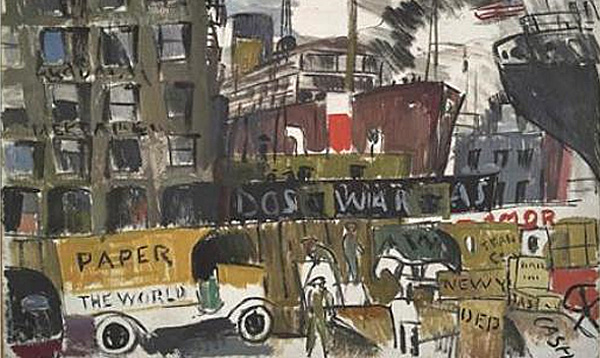"Nueva York" Turns Lens South to NY Hispanic Roots
 Walker Simon - Reuters Walker Simon - Reuters
go to original
September 11, 2010


| | An undated handout photo shows Joaquin Torres-Garcia's (Uruguay, 1874-1949) New York Docks, a 1920 oil and gouache on cardboard, is among the exhibits tracing New York's deep and extensive historical roots with the Spanish-speaking world in the exhibition " Nueva York (1613- 1945)," a collaboration of The New-York Historical Society and El Museo del Barrio. (Reuters/Yale University Art Gallery) |  |
New York - A new exhibit at El Museo del Barrio turns an historic lens on New York's north-south relations, highlighting its long and deep roots with the Spanish-speaking world.

"Nueva York: 1613-1945," which opens on September 17 and runs until early next year, depicts the city as a cultural crossroads for artists, intellectuals and revolutionary agitators from Spain, Latin America and the Caribbean.

Hostile or amicable, New York's Latin America ties fueled its rise as an economic power, according to the exhibit, enriching families such as the Guggenheims.

"For most New Yorkers, the show's surprise will be that New York's extensive ties to the Spanish-speaking world do not begin after the Second World War, the period of massive Latin American immigration, but 300 years earlier," curator Marci Reaven said an interview.

The exhibit features about 200 objects, including rare maps, letters, paintings, photos, books and announcements.

The city's oldest museum, the New York Historical Society joined El Museo del Barrio in organizing the exhibit.

The show opens with the story of Juan Rodriguez, an Afro-Caribbean from Santo Domingo who arrived in 1613. He was Manhattan's first recorded Hispanic resident who was here for at least a year. The first group of Spanish speakers were 23 Sephardic Jews, who fearing persecution in Brazil, arrived in 1654.

A false-bottomed barrel concealing Spanish silver coins under green coffee beans shows how New York merchant families reaped wealth from often-illicit trade with Spanish colonies.

"Little known is that Spanish silver coins were a key currency in New York and throughout the British colonies through the Revolutionary War and even into the first decades of the United States," said Reaven.

The exhibit also reveals that New York's first Roman Catholic church, authorized in 1785, was funded by Spain's Carlos III, Mexican silver barons and the archbishops of Puebla and Mexico City.

As New York's trade surged with newly independent Latin America, Spanish businessmen founded New York's first Spanish-language daily, El Mercurio, in 1828.

By the 1840s, New York published many Spanish-language books for export, including New York guidebooks and children's books like "Beauty and the Beast" and "Ali Baba and the 40 Thieves," which are displayed in the exhibit.

New York became the main exile base of refugees from Spain's remaining colonies in the Caribbean, Cuba and Puerto Rico. An entire gallery traces the local development of organizations which raised funds, collected weapons and published dozens of newspapers which advocated independence.

The show's 20th century section traces the popularization of Argentine tango, Cuban rumba and Dominican merengue as well as Latin American artists.

Visitors can select and listen to up to 31 of the most popular Latin songs, the bulk produced in New York, performed largely by Caribbean and Latin American musicians.

"Most people, including Latinos themselves, still do not appreciate how deeply our roots are sunk into this city," said Julian Zugazagoitia, outgoing director of El Museo del Barrio. |



